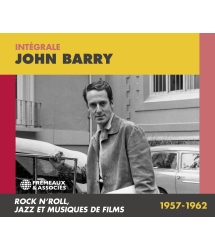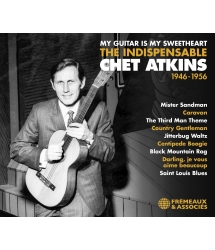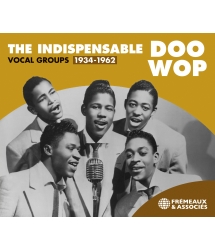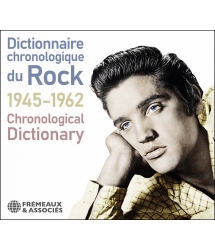- Notre Catalogue
- Philosophie
- Philosophes du XXème siècle et d'aujourd'hui
- Histoire de la philosophie (PUF)
- Contre-Histoire et Brève encyclopédie par Michel Onfray
- L'œuvre philosophique expliquée par Luc Ferry
- La pensée antique
- Les penseurs d'hier vus par les philosophes d'aujourd'hui
- Textes philosophiques historiques interprétés par de grands comédiens
- Histoire
- Livres
- Sciences Humaines
- Paroles historiques
- Livres audio & Littérature
- Notre Catalogue
- Jazz
- Blues - R'n'B - Soul - Gospel
- Rock - Country - Cajun
- Chanson française
- Musiques du monde
- Afrique
- France
- Québec / Canada
- Hawaï
- Antilles
- Caraïbes
- Cuba & Afro-cubain
- Mexique
- Amérique du Sud
- Tango
- Brésil
- Tzigane / Gypsy
- Fado / Portugal
- Flamenco / Espagne
- Yiddish / Israël
- Chine
- Tibet / Népal
- Asie
- Océan indien / Madagascar
- Japon
- Indonésie
- Océanie
- Inde
- Bangladesh
- URSS / Chants communistes
- Musiques du monde / Divers
- Musique classique
- Compositeurs - Musiques de film - B.O.
- Sons de la nature
- Notre Catalogue
- Jeunesse
- Philosophie
- Nouveautés
- Comment commander ?
- Recevoir le catalogue
- Manifeste
- Dictionnaire











- Notre Catalogue
- Philosophie
- Philosophes du XXème siècle et d'aujourd'hui
- Histoire de la philosophie (PUF)
- Contre-Histoire et Brève encyclopédie par Michel Onfray
- L'œuvre philosophique expliquée par Luc Ferry
- La pensée antique
- Les penseurs d'hier vus par les philosophes d'aujourd'hui
- Textes philosophiques historiques interprétés par de grands comédiens
- Histoire
- Livres
- Sciences Humaines
- Paroles historiques
- Livres audio & Littérature
- Notre Catalogue
- Jazz
- Blues - R'n'B - Soul - Gospel
- Rock - Country - Cajun
- Chanson française
- Musiques du monde
- Afrique
- France
- Québec / Canada
- Hawaï
- Antilles
- Caraïbes
- Cuba & Afro-cubain
- Mexique
- Amérique du Sud
- Tango
- Brésil
- Tzigane / Gypsy
- Fado / Portugal
- Flamenco / Espagne
- Yiddish / Israël
- Chine
- Tibet / Népal
- Asie
- Océan indien / Madagascar
- Japon
- Indonésie
- Océanie
- Inde
- Bangladesh
- URSS / Chants communistes
- Musiques du monde / Divers
- Musique classique
- Compositeurs - Musiques de film - B.O.
- Sons de la nature
- Notre Catalogue
- Jeunesse
- Philosophie
- Nouveautés
- Comment commander ?
- Recevoir le catalogue
- Manifeste
- Dictionnaire
CAR TUNE CLASSICS 1942 - 1962
Ref.: FA5401
EAN : 3561302540122
Direction Artistique : BRUNO BLUM
Label : Frémeaux & Associés
Durée totale de l'œuvre : 2 heures 57 minutes
Nbre. CD : 3
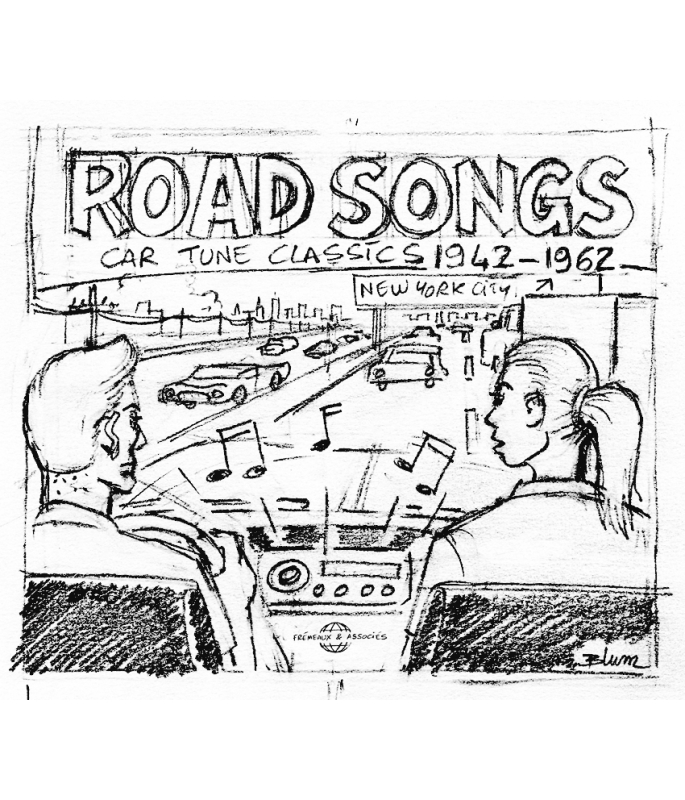
CAR TUNE CLASSICS 1942 - 1962
Conçu pour être écouté au volant comme chez soi, ce triple album se fait l’écho d’un certain «mode de vie américain» à une époque où la voiture en était l’un des plus éclatants symboles. Cette anthologie regroupant rock, jazz, western swing, blues et country constitue un document de référence sur la mise en scène du mythe automobile dans la musique populaire américaine. Commentés par Bruno Blum dans un livret 28 pages, ces titres remarquables ont été sélectionnés selon des critères de qualité : composition, paroles, interprétation et dans la mesure du possible clarté du son pour un confort d’écoute maximal.
Patrick FRÉMEAUX
Conceived as music for listening behind the wheel or at home, this triple album echoes the “American Way of Life” back in the days when the automobile was a striking symbol. This anthology featuring rock, jazz, western swing, blues and country music is a landmark audio-collection illustrating the car-myth in American popular music. The 28-page booklet contains detailed notes by Bruno Blum, and these remarkable titles were all chosen for their quality: compositions, lyrics, performance… and, wherever possible, great sound, the kind you need wherever you take the music.
Patrick FRÉMEAUX
DROITS : FREMEAUX & ASSOCIES / DP.
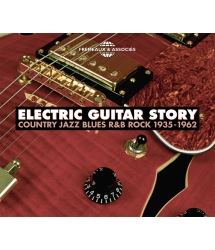
ROCK COUNTRY JAZZ BLUES R&B (1935-1962)
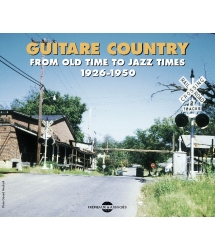
FROM OLD TIME TO JAZZ TIME 1926 - 1950
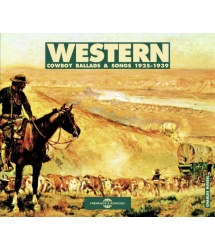
ANTHOLOGIE 1925-1939
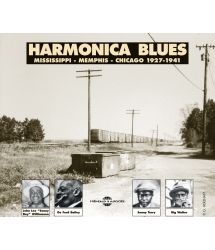
MISSISSIPI - MEMPHIS - CHICAGO 1927 - 1941
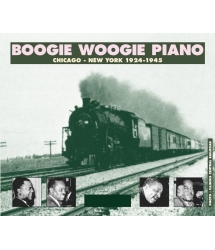
CHICAGO - NEW YORK 1924-1945






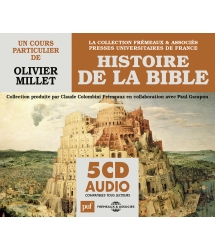
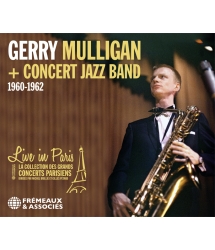
-
PisteTitreArtiste principalAuteurDuréeEnregistré en
-
1(Get Your Kicks on) Route 66Nat King ColeRobert William Troup Jr00:03:031946
-
2Won't You Ride in my Little Red WagonTex WilliamsRex Griffin00:01:511947
-
3Automobile BluesLightnin' HopkinsSam Hopkins00:02:481949
-
4Car RiderArne DommérusArne Domnerus00:03:001949
-
5Hot Rod RaceRamblin' Jimmie DolanGeorges Wilson00:02:331950
-
6Hot Rod Race Navy StyleMick WoodwardGeorges Wilson00:02:041951
-
7Hardtop RaceDave StogerDave Stogner00:02:401951
-
8Hot Rod - Shotgun Boogie No.2Tillman Franks and his Rainbow BoysPierce00:02:531951
-
9Hot Rod Race N°3Bob WilliamsArkie Shibley00:02:271951
-
10Let Me Ride Your AutomobileLowell FusionArkie Shibley00:02:451951
-
11Swing Low, Sweet CadillacDizzy GillespieDizzy Gillespie00:03:021951
-
12Rocket 69Connie Allen, Todd Rhodes and his OrchestraHenry Glover00:02:451951
-
13Rocket 88Jackie BrensonJackie Brenson00:02:511951
-
14Diesel Smoke, Dangerous CurvesBilly StrangeWilliam Everett Strange00:02:071952
-
15Cadillac BluesBig Walter HortonBig Walter Horton00:02:391951
-
16Mobiling Baby of MineEddie MarshallMarshall00:02:221951
-
17Driving This HighwayHowlin' WolfHowlin' Wolf00:02:551952
-
18Motor Head BabyJohnny WatsonJohnny Watson00:02:381952
-
19Buick '59The MedallionsGreen00:02:391954
-
20Cadillac in Model ABon Wills and his Texas PlayboyWills00:02:071954
-
21No Money DownChuck BerryChuck Berry00:02:591955
-
22The RouteChet Baker and Art PepperChet Baker00:05:071956
-
23UAW-CIOThe Union BoysVern Partlow00:02:031944
-
PisteTitreArtiste principalAuteurDuréeEnregistré en
-
1(Get Your Kicks on) Route 66Bobby TroupRobert William Troup Jr00:02:271955
-
2Cops and RobbersBoogaloo and his Gallant CrewHarris00:03:011956
-
3Highway 60Johnny WatsonWatson00:02:271953
-
4Mr. ThrillMildred JonesMildred Jones00:02:351954
-
5Coupe Deville BabyVernon GreenNathaniel Hinton00:02:371954
-
6You Can't Catch MeChuck BerryNathaniel Hinton00:02:441955
-
7MaybelleneChuck BerryNathaniel Hinton00:02:261955
-
8Come Back, MaybelleneMercy DeeMercy Dee Walton00:02:311955
-
9Speedin'Vernon Green and The MedallionsMcAdoo00:02:121955
-
10Parking WorriesTed WestWest00:02:531955
-
11No Parking HereJimmy LittlejohnMelvine Romine00:02:311955
-
12Dig That Hot RodPaul WestmorelandPaul Westmoreland00:02:221954
-
13Hot Rod RagT. Texas TylerPaul Westmoreland00:02:141953
-
14TaxiAl Harris and his Calypso BandA. Harris00:02:421956
-
15Hard Top RaceMerrill MooreStogner00:02:111953
-
16Race With the DevilGene Vincent and his Blue CapsStogner00:02:061956
-
17Cruisin'Gene Vincent and his Blue CapsGene Vincent00:02:151956
-
18Pink CadillacSammy MastersMasters00:02:181956
-
19Drivin' Down The Wrong Side of the RoadRichy RiddleThomas00:02:421956
-
20Let's Coast a WhileBo DavisB. Davis00:02:031956
-
21Cruisin'Clark TerryClark Terry00:08:281957
-
22Hot Rod RockThe Hot Rod Rumble OrchestraSandy Courage00:03:091957
-
PisteTitreArtiste principalAuteurDuréeEnregistré en
-
1(Get Your Kicks on) Route 66Chuck BerryRobert William Troup Jr00:02:491961
-
2Hot RodThe Mar-KeysMorton00:02:251958
-
3Flat TireThe Del-VikingsOtis00:02:301958
-
4Pop, Let Me Have the CarCarl PerkinsAndy Halmay00:02:151958
-
5Sur l'autorouteMiles Davis00:02:211957
-
6MilestonesMiles Davis00:05:411958
-
7Du Jazz dans le ravinSerge GainsbourgSerge Gainsbourg00:02:121958
-
8Brand New CadillacVince Taylor and his PlayboysVince Taylor00:02:371959
-
9Road RunnerBo DiddleyBo Diddley00:02:471959
-
10Hot Rod LincolnCharlie RyanW.S. Stevenson00:02:341955
-
11Black and White ThunderbirdThe DelicatesBilly Mure00:02:141959
-
12Ride on JosephineBo DiddleyEllas Mcdaniel00:03:031960
-
13Jaguar and ThunderbirdChuck BerryChuck Berry00:01:531960
-
14Push Button AutomobileVernon GreenLeroy Jenkins00:02:511956
-
15CadillacBo DiddleyLeroy Jenkins00:02:461959
-
16Forty Miles of Bad RoadDuane EddyAl Casey00:02:051959
-
17ShowEddie CochranEddie Cochran00:02:071957
-
18Why Don't You People Learn to DriveGene VincentJames Noble00:02:001959
-
19Hit the Road JackRay CharlesPercy Mayfield00:02:001961
-
20Highway 51Bob DylanRobert Zimmerman00:02:531961
-
21Route 66 ThemeNelson Riddle and his OrchestraNelson Riddle00:02:081962
Road songs FA5401
Road songs in America
1944 - 1962
Car Tune Classics par bruno blum
Le premier succès américain sur le thème de la voiture, In my Merry Oldsmobile de Billy Murray, date de 1905. Après la Seconde Guerre Mondiale, suite notamment au succès de Rocket 88 par Jackie Brenston et Hot Rod Race par Arkie Shibley (qui comme Charlie Ryan gravera toute une série de chansons sur ce sujet), les road songs sont devenus un véritable genre.
Cette anthologie tente de constituer un document audio de référence sur la mise en scène du mythe automobile dans la musique populaire américaine. Ces titres ont été sélectionnés selon des critères de qualité : composition, paroles, interprétation, style et dans la mesure du possible clarté du son, pour un confort d’écoute maximal, pour le plaisir de la musique. Conçu pour être écouté au volant comme chez soi, cet album évocateur permet de ressentir l’ambiance du « Mode de Vie Américain » à une époque où la voiture individuelle le symbolisait.
American Way of Life
L’American Way of Life a été décrit par plusieurs auteurs comme étant le triomphe de la liberté encadrée par la constitution, la démocratie et la loi. C’était sans compter que ce noble objectif soit souvent indistinct d’un consumérisme confondu avec l’idée de liberté. Érigé en idéal, dans les années 1950 ce mode de vie individualiste était centré sur l’auto. Il est devenu le « Rêve Américain », une expression popularisée par James Truslow Adams en 1931 :
« Il ne s’agit pas d’un rêve de voitures automobiles mais d’un rêve d’ordre social où chaque homme et chaque femme sera capable de réaliser pleinement ce dont il a les capacités, et d’être reconnu par les autres pour ce qu’il est, en faisant abstraction des circonstances fortuites de sa position sociale ou de sa naissance1.»
Mais après vingt années de récession et de guerres, ce rêve était teinté d’inégalités sociales, de racisme, de nationalisme, de religion omniprésente - et un matérialisme renforcé par une croissance économique forte. Entre 1950 et 1960, le pouvoir d’achat américain a augmenté de 30 %. Avec le crédit facile, un développement de la construction et de la production sans précédent, la publicité assurait une forte demande. Cette société de consommation prospère fut incarnée par le président Dwight D. Eisenhower, un militaire conservateur au pouvoir de 1953 à 1961.
L’Amérique mutait dans l’ère du confort moderne, de l’électro-ménager et de la société du spectacle : télévision, cinéma, comic books, jazz moderne, country & western et rock & roll. Cette proposition sociétale était indissociable de l’expansion de l’automobile, ses gadgets et ses options, comme la radio. Le tout acheté à crédit comme le chante Chuck Berry avec humour sur No Money Down. À la fin des années 1950 les mustangs, les diligences, les trains à vapeur faisaient partie de l’histoire, mais la sacro-sainte liberté passait toujours par la liberté de mouvement dans ce pays gigantesque où de grandes distances doivent être parcourues au volant. Pour la jeunesse, conduire était une marque d’émancipation. Les parents devaient prêter leur véhicule aux adolescents, comme le chantent Carl Perkins dans Pop, Let Me Have the Car. Sur Cruisin’, Gene Vincent cherche un rival dans toute la ville pour lui régler son compte2.
La clé d’une voiture était la matérialisation d’une liberté promise après deux décennies de désastre économique et de guerre mondiale. Une automobile aidait à séduire (Won’t You Ride in my Little Red Wagon), permettait d’inviter une femme au spectacle chanté par Eddie Cochran dans Drive-In Show et de lui faire la cour discrètement, confortablement assis sur la banquette avant d’une énorme sedan ; Elle rendait possible une résidence plus économique en banlieue, des vacances en famille - un standing devenu la norme.
Route 66
Les immenses villes américaines sont organisées autour de l’automobile avec de larges avenues parallèles et rectilignes. O Street à Lincoln (Nebraska) mesure plus de 120 km. Avec 60 millions de voitures aux États-Unis en 1955, les embouteillages et les problèmes de stationnement dépassaient les bornes. Ils sont chantés ici dans Parking Worries et No Parking Here. L’instrumental rock3 Forty Miles of Bad Road de Duane Eddy évoque, lui, la vétusté des routes. Et sur Why Don’t You People Learn to Drive, Gene Vincent critique les chauffards sur les routes encombrées.
Commandant suprême des forces alliées en Europe pendant la Seconde Guerre Mondiale, le président « Ike » Eisenhower avait admiré les autoroutes allemandes. À son tour, le président décida de mettre en chantier un réseau autoroutier moderne reliant 209 des 237 grandes villes américaines. Signé le 13 août 1956, le premier contrat lançait la construction d’une autoroute visant à doubler la Route Nationale 66 saturée. « The Mother Road » est la voie légendaire reliant Chicago à Los Angeles selon l’itinéraire de 3945 km chanté ici dans trois interprétations de (Get Your Kicks on) Route 66. Une future version ouvrira le premier album des Rolling Stones en 1964 : elle participera à ancrer l’image du groupe britannique dans le mythe américain auquel il se référait constamment. Le plaisir de conduire au son de la musique américaine séduisait l’Europe, comme le raconte ici Serge Gainsbourg à ses débuts dans Du Jazz dans le ravin. Route 66 a été écrit en 1946 par Bobby Troup, un chanteur et pianiste de jazz blanc déjà compositeur de succès pour Frank Sinatra, Glenn Miller et les Andrew Sisters. L’auteur de ce standard du rock dévoile ici son style jazzy. Sa chanson, sa voix détachée et son style swing allaient comme un gant à Nat « King » Cole, un excellent pianiste de jazz qui s’était lancé avec succès et talent dans la chanson. Cet enregistrement fondateur a valu à King Cole un de ses premiers succès (R&B #3, 1946) entré dans le top 15 des classements pop nationaux. Il chatouillait la fibre nationaliste de l’après-guerre, friande en allusions à la grandeur de l’Amérique. Construite à partir de 1926, en1956 la Route 66 représentait déjà la nouvelle civilisation de l’automobile, qui était célébrée au même plan que la conquête de l’ouest et bientôt la conquête spatiale : une aventure humaine. Écrite en 1951 sur le thème de la quête d’identité, la nouvelle visionnaire On the Road de Jack Kerouac évoque la vie de routard comme une expérience philosophique. Publiée en 1957, elle annonçait le thème central de la contre-culture des années 1960, la quête de soi dans le voyage. Le « trip » serait bientôt suggéré à tous les niveaux par les beatniks : invitation au voyage physique - sur fond d’excursions vers la lune - voyage spirituel, musical, sexuel, et bien sûr, voyage au LSD.
Sur le délicieux Diesel Smoke, Dangerous Curves, Billy Strange évoque déjà les aléas de la route au volant d’un camion. Le chauffeur se réveille le lendemain avec une gueule de bois et une fille dont il ne connaît pas le nom - avant d’avoir un accident. Sur la version originale de Cops and Robbers, un sketch humoristique par Boogaloo and the Gallant Crew, un auto-stoppeur braque le chauffeur qui le transporte. Cette perle sera enregistrée plus tard par Bo Diddley4 et les Rolling Stones. La Route 66 était fréquentée par les vacanciers qui partaient se baigner en Californie. De 1960 à 1964 elle a donné son nom à une série télévisée retraçant les aventures de jeunes voyageurs intrépides à bord d’une splendide Chevrolet Corvette. On peut écouter ici Route 66 Theme, le magnifique générique du feuilleton où le personnage de Buz a été inspiré par Jack Kerouac. Dans son élégant arrangement, Nelson Riddle cite presque le solo de piano de Nat «King » Cole.
Au siècle suivant, l’histoire de la Route 66 sera mise en perspective dans le dessin animé à succès Cars (Walt Disney/Pixar 2006) où la musique rock tient une grande place et où l’on peut entendre la version de Chuck Berry : en effet avec le développement de la radio dans l’après-guerre, les musiques rock, jazz, blues et country étaient devenues indissociables du mythe automobile. Les véhicules étaient équipés de postes de radio compagnons des routiers qui restaient parfois éveillés avec l’aide d’amphétamines - alors en vente libre. La radio accompagnait aussi les pérégrinations des automobilistes, comme le chante ici Chuck Berry dans son chef-d’œuvre romantique You Can’t Catch Me, où il compare sa voiture à un avion :
En plein vol samedi soir/Pas de nuage gris en vue/Une grosse pleine lune brillait au-dessus de nous/Viens faire un calin chérie, tu es mon amour/La plus douce que j’ai jamais vue/Je vais t’appeler Maybellene/On s’est envolé dans le faisceau des phares/En pilote automatique/La radio réglée sur du rock ‘n’ roll.
Motor City
Le réseau autoroutier Interstate Highway System d’Eisenhower coûta l’équivalent de plus de 400 milliards de dollars de 2006, le plus grand chantier de service public de l’histoire. Cet investis-sement considérable orienterait pendant des décennies la politique américaine vers le tout automobile et sa boulimie de pétrole. Pourtant en coulisse, le développement de l’automobile américaine avait un visage moins séduisant que la griserie des balades en décapotable. Le moteur V8 à huit cylindres s’est imposé sur les Cadillac dès 1914. Des modèles de toutes marques étaient équipés de V8. Un gros V8 Cadillac de 1955 brûlait pas moins de 24 litres d’essence aux cent km.
Avant que le budget du National Interstate and Defense Highways Act soit voté en 1956, le Congrès Américain a subi les pressions des géants du pétrole et de l’automobile, pour qui ces autoroutes représentaient un pactole infini. En 1953-54, une guerre des prix a eu raison de plusieurs marques indépendantes, ce qui a encore décuplé la puissance de la troïka Ford-GM-Chrysler. S’y est ajouté le lobbying de l’industrie de l’armement, qui se confondait souvent avec la corporation de l’automobile. Selon les fabricants d’armes, la libre circulation des matériels et des troupes par la route était indispensable à la défense du pays. En pleine guerre froide, à l’issue de la période maccarthyste et de la guerre de Corée (1950-1953), le Général Eisenhower était très sensible aux arguments de nature militaire. Et pour favoriser la croissance de son pays, il ferma les yeux sur les aspects les moins reluisants des constructeurs. En effet l’industrie automobile pratiquait le travail à la chaîne, une méthode productiviste radicale inspirée par l’élevage intensif et développée dans les usines d’Henry Ford (1863-1947) dès les années 1900. Ford pratiquait une lutte violente contre les syndicats ouvriers, qu’il exécrait. Henry Ford, son fils Edsel et petit-fils Henry II ont employé beaucoup d’ouvriers afro-américains dans leurs gigantesques usines de Detroit, où le coriace syndicat U.A.W. acceptait les Noirs - et les communistes en plein maccarthysme. Cette opportunité d’emploi motivait l’exode vers le nord de beaucoup d’Afro-américains qui avaient quitté le misérable sud ségrégationniste pour Motor City, capitale mondiale de l’automobile. C’est d’ailleurs là qu’en 1959 naquirent les disques Motown, qui feront de Detroit une ville clé de la pop music afro-américaine.
Effort de guerre
Henry Ford avait lancé la Ford T, qui en 1908 a démocratisé l’automobile aux États-Unis. Immensément riche il était aussi connu pour ses écrits et publications antisémites, dont l’abject Protocole des sages de Sion, un faux provocateur intentionnellement attribué à des Juifs et publié par un de ses proches. Adolf Hitler rendit hommage à ses idées d’extrême-droite dans Mein Kampf. Ford avait investi dans la machine militaire nazie et tira entre autres des bénéfices importants des moteurs d’avions militaires, les redoutables Messerschmitt.
Jusqu’à Pearl Harbour (décembre 1941), cette félonie n’est pas restée isolée. Son grand concurrent General Motors (Buick, Cadillac, Chevrolet, Pontiac, Oldsmobile, électroménager, etc.), avait été propriétaire des usines Opel situées en Allemagne nazie. GM a perçu d’énormes bénéfices sur les productions militaires allemandes dans lequel il avait investi - en contradiction avec les intérêts vitaux du peuple américain bientôt en guerre contre l’Allemagne. Lié à la famille Thyssen, le riche banquier Prescott Bush a lui aussi renta-blement investi dans l’effort de guerre nazi. Il sera quand même élu gouverneur républicain du Connecticut en 1952 (en 2003 son petit-fils, le président George W. Bush, sera mis en cause pour des pratiques analogues en Irak). Naturellement Chrysler (Dodge, DeSoto, Vailant, Plymouth, Jeep, Imperial), General Motors et Ford avaient aussi produit du matériel de guerre américain : on a vite passé l’éponge sur leurs caricaturales pratiques capitalistes transnationales.
La chanson U.A.W.-C.I.O. (noms des principales centrales syndicales de l’industrie américaine) illustre la lutte sans merci qui opposait les travailleurs de l’automobile à leurs patrons. The Union Workers (avec les grands noms du folk Sonny Terry, Brownie McGhee, Josh White, Pete Seeger, Alan Lomax, Burl Ives, etc.) y chantent que c’est grâce à leur travail que les ouvriers américains ont assuré la victoire contre l’Allemagne nazie. Pour eux, on devrait « estampiller Berlin avec un tampon de l’U.A.W. » après la victoire. Plusieurs de ces musiciens figureront sur la liste noire des présumés communistes combattus par le sénateur McCarthy. Voici un extrait de leur protest song, enregistrée à la fin de la guerre :
Tous les tanks de mon camp sont estampillés de l’U.A.W./Moi je suis de l’U.A.W. aussi et j’en suis fier […] C’est l’U.A.W.-C.I.O./Qui fait rouler et avancer l’armée/Qui produit les Jeeps les tanks et les avions tous les jours/Qui met les États-Unis sur roues […] J’étais là quand le syndicat est allé en ville/J’étais là quand le vieux Henry Ford est tombé/J’étais à la Porte Quatre/Quand j’ai entendu la clameur du peuple : On ne se moquera plus des travailleurs de l’automobile !
Hot Rods, Custom & Stock Cars
Après la guerre, nombre de militaires sont revenus de « la mauvaise vie » avec une formation de mécanicien et ont voulu retaper des voitures d’avant-guerre. Au retour des combats, des soldats démobilisés ont développé les courses de hot rods, des voitures modifiées, allégées, aux mo--teurs gonflés et aux carrosseries décorées. Les hot rods évolueront vers le dragster. Mais dès le milieu des années 50, ils circulaient sur les routes, comme l’évoque Gene Vincent dans Race With the Devil :
J’ai vécu une mauvaise vie qu’ils disent/Mais le jour du Jugement Dernier, le diable ne pourra pas me rattraper/J’ai dit fonce, hot rod, fonce ! […] J’allais à toute allure, je me suis retourné/Et j’ai entendu le diable arriver à 99 à l’heure !/ J’ai dit fonce, hot rod, fonce !
Les courses de hot rods avec départ arrêté avaient lieu dans les déserts de Californie ou des aéroports désaffectés. On y réalisait des pointes de vitesse pure sur de courtes distances. À la mode au début des années 1950, plusieurs country boogies5 leur ont été consacrés par des musiciens de western swing, comme l’irrésistible Hot Rod Race de Ramblin’ Jimmy Dolan. La version originale de novembre 1950 par Arkie Sibley and his Mountain Dew Boys avait lancé la mode des hot rod songs. Une dizaine de titres hot rod sont inclus ici, dont le Hot Rod Rumble extrait de la bande du film du même nom. Les obscurs Hot Rod Race et Hot Rod Lincoln restent deux hymnes de cette culture.
Les courses automobiles ont donné lieu à nombre de chansons comme Hardtop Race où Dave Stogner (et la reprise de Merrill Moore) relate une course de stock cars (voitures de série). La popularité des courses a logiquement débouché sur des modèles de série de plus en plus rapides. Les Medallions chantent la vitesse sur Speedin’. Dans Jaguar and Thunderbird, Chuck Berry évoque une voiture de police qui n’arrive pas à rattraper deux chauffards en excès de vitesse. À la fin des années 1950 et par la suite, la mode est passée à la vitesse, comme le chante Bo Diddley dans Road Runner6, un morceau sur le coucou du désert (geococcyx californianus) du dessin animé Bip Bip et Vil Coyote :
Je suis un road runner chérie/Bip bip !/Et tu ne peux pas me rattraper/Faisons la course/Chérie tu vas voir/Me voilà/Bip bip !
Les quelques titres de jazz moderne inclus ici évoquent la route, mais sans paroles. La rapidité du tempo en phase avec le courant bebop suggère un effet de vitesse sur Milestones (« bornes»), Sur l’autoroute (Miles Davis), Car Rider (Arne Domnérus et James Moody) et Cruisin’ (Chet Baker/Art Pepper).
Prestige
La clientèle était aussi en demande de voitures de prestige comme la splendide Chevrolet Bel Air de 1957. Le design, les ornements, le confort, la couleur et les options modernes étaient des arguments de vente. Fonctionnelles, conservatrices et mastoc dans l’après-guerre, les voitures sont devenues plus basses, plus longues, plus larges et plus fines, avec versions coupé pour la ville, décapotable, break, etc. À la fin de la décennie, les ailes fines en « nageoire » surdimensionnées, les chro-mes et les carrosseries multicolores étaient partout. C’est ce type de modèle sophistiqué qu’achète Chuck Berry dans No Money Down : Je veux l’air conditionné/Et le chauffage automatique/Je veux un lit dépliant complet/Dans ma banquette arrière/Je veux la radio à ondes courtes/La télévision et le téléphone : il faut que je parle à ma chérie/Quand je suis seul au volant.
Dans leur Push Button Automobile, les Medallions disposent de boutons pour toutes les fonctions, y compris celle de rapprocher automatiquement leur chérie. Après des années de privations, posséder une voiture était d’abord une marque de standing. Le choix d’une auto exprimait sa personnalité, son style et son niveau social. Les modèles se sont beaucoup diversifiés au milieu des années 1950, visant les sportifs (Chevrolet Corvette) ou les seniors (Ford Falcon), les citadins (Studebaker Commander Starliner), les ruraux (pick up truck comme le Dodge Power Wagon) ou les riches (Cadillac). Sans oublier les dames avec par exemple l’élégante Ford Thun-derbird, la « voiture personnelle » chantée par le groupe féminin The Delicates.
Le salon de l’auto était un événement populaire, un temple de la consommation où les marques dévoilaient leurs innovations. En 1954, le groupe vocal The Medallions imaginait être seul à posséder la nouvelle Buick cinq ans avant sa sortie. Dérivé du morceau Rocket 69 de 1951, Buick ‘59 n’a pas marché en 1954, mais réédité en 1959 au moment où sortait la vraie Buick dernier cri de 59, en plein salon de l’auto, il a obtenu un gros succès.
Quant au légendaire Rocket 88, il a la réputation d’être le « premier morceau de l’histoire du rock», un poncif vite remis en perspective à l’écoute des huit volumes de la série Rock n’ Roll sur les origines du rock dans cette collection. En réalité ce morceau a cette renommée car il a été enregistré par Bill Haley, un des premiers artistes blancs à reprendre une composition de rock7. Inspiré par le Cadillac Boogie de Jimmy Liggins, il a sans doute été à l’origine de la mode des chansons sur les voitures, les car tunes qui a vite suivi celle des hot rod songs. Rocket 88 chante les vertus de l’Oldsmobile 88, un modèle de 1949 mis à jour chaque année qui gagnait toutes les courses de stock cars de son temps.
Cadillac Baby
La future star du funk Johnny « Guitar » Watson était un rocker et bluesman. En argot américain, « motor head » est un consommateur d’amphétamines, qui vit à cent à l’heure et ne dort pas la nuit. Son Motor Head Baby évoque une femme circulant en Cadillac, le symbole incontesté de la voiture américaine de luxe. Plusieurs chansons y font référence ici, du Pink Cadillac de Sammy Masters (début 1955, Elvis Presley s’était offert une Cadillac Fleetwood rose) au Highway Man de Howlin’ Wolf, sans oublier le classique de Vince Taylor Brand New Cadillac, qui deviendra célèbre une fois enregistré par The Clash en 1980. Dans les negro spirituals, le chariot qui emmène les bons chrétiens au paradis dans le standard Swing Low, Sweet Chariot est en langage codé le chariot bâché qui permettait en fait de fuite des esclaves vers les états abolitionnistes. Le trompettiste Dizzy Gillespie l’a tourné en dérision avec son Swing Low, Sweet Cadillac. Sur Cadillac in Model A, les rois du western swing Bob Wills et Billy Jack Wills chantent les vertus d’une vieille Ford A rénovée qui leur donne l’impression de descendre en ville « en Cadillac ». Les voitures d’occasion en bon état étaient bien plus branchées que les neuves. C’est ce que chantait Bo Diddley en 1959 dans l’excellent Ride on Josephine, où il fait la course avec une femme :
Je conduis une Cadillac de 48/Avec des ailes thunderbird/Et crois-moi chérie, elle marche bien !
Dans la chanson américaine, les voitures sont représentées comme un argument de séduction. Et aux avances d’un prétendant(e) qui mettait en valeur sa Cadillac, le séducteur(trice) répondait souvent « J’en ai déjà une » - comme Etta James dans The Pick Up ou ici Bo Diddley sur Cadillac (qui sera bientôt enregistré par les Kinks à Lon-dres). Sur son célèbre Maybellene, le monstre sacré du rock Chuck Berry poursuit une femme qui se déplace dans une somptueuse Cadillac Coupe DeVille. Logiquement, la voiture devenait une métaphore pour décrire le partenaire lui-même, comme sur le Coupe DeVille Baby des Medallions ou le blues Let Me Ride in Your Automobile de Lowell Fulson. Cette analogie est récurrente sur cet album, et va toujours plus loin, culminant avec les doubles sens salaces du Mr. Thrill de Mildred Jones :
Mon chéri a une longue longue longue…/Cadillac[…] Quand il la met… han !/Quand il la met dans mon garage/Il conduit doucement/Car il ne veut pas décharger ses batteries
Highway Blues
Après des siècles d’une inimaginable oppression, en 1950 la ségrégation raciale était officiellement en vigueur dans le sud - et restait une réalité tangible dans presque tout le nord. La communauté afro-américaine avait peu d’accès à l’emploi, au crédit, au logement et à l’automobile. Pour elle, la voiture était donc d’autant plus prestigieuse. Sur Automobile Blues, le grand bluesman texan Lightnin’ Hopkins raconte comment sa femme - qui préfèrera en fin de compte son amour sincère - se laisse séduire par le propriétaire d’une voiture neuve.
Mais chez les Afro-américains, le thème de la route évoquait surtout une dimension métaphysique : le destin conduisait le musicien accablé à errer dans une jungle d’asphalte hostile, seul avec son chagrin d’amour, sa guitare et son pathos. Dans le stéréotype du bluesman vagabond (hobo) abandonné, l’autoroute est couramment une mé-ta--phore de solitude, de rejet, de départ mélancolique. Le standard Key to the Highway de Big Bill Broonzy8 en est caractéristique. Cette évocation de la route a largement influencé l’imagerie de la musique populaire américaine. En droite ligne de cette tradition lyrique du folk blues, Bob Dylan le cœur brisé chante ici le nom de l’autoroute au bord de laquelle il veut être enterré, le Highway 51 qui mène du nord des États-Unis (il est originaire du Minnesota) à la Louisiane, source du blues. Sur Highway 60, Johnny « Guitar » Watson est comme Dylan errant à la recherche de son amour perdu. Le plus fameux des morceaux sur ce thème est peut-être le Hit The Road Jack de Ray Charles, où le chanteur rejeté par une femme doit prendre la route.
Quant au calypso Taxi de Al Harris, il a été enregistré aux Bermudes, un archipel anglophone de l’océan Atlantique très lié aux États-Unis9. Harris s’y plaint de l’augmentation du prix des taxis, et souhaite que l’on remette en service le bon vieux train, plus économique.
Bruno Blum, 2012
Merci à Yves Calvez, Christophe Hénault, Frédéric Régent, Gilbert Shelton, Alain Tercinet, Michel Tourte, Fabrice Uriac et Gilles Verlant.
© Frémeaux & Associés, 2013
1. L’historien John Truslow Adams in The Epic of America, 1931.
2. Écouter aussi le triple album Gene Vincent & His Blue Caps 1956-1958 dans cette collection.
3. Retrouvez Duane Eddy et l’histoire du rock instrumental sur Rock Instrumentals 1935-1961 dans cette collection.
4. La version de Bo Diddley est disponible sur le triple Bo Diddley - The Indispensable 1955 - 1960 (FA 5360).
5. Écouter Country Boogie 1939 - 1947 dans cette collection (FA 160).
6. Ce titre est aussi disponible sur le triple Bo Diddley - The Indispensable 1955 - 1960 (FA 5360).
7. Les deux versions de Rocket 88 sont disponibles dans le volume Rock n’ Roll 1951 dans cette collection (FA357).
8. La version de Key to the Highway de Big Bill Broonzy est incluse dans Big Bill Broonzy - The Blues - Chicago 1937 - 1945 (Frémeaux et Associés FA252).
9. Écouter l’anthologie Bermuda - Gombey & Calypso 1953 -1960, où l’on retrouve ce morceau et d’autres d’Al Harris.
Road songs in America
1944 - 1962
Music to Play in Cars
BY bruno blum
The very first American hit featuring a car was Billy Murray’s In my Merry Oldsmobile dated 1905. After World War II, and hits like Jackie Brenston’s Rocket 88 or Hot Rod Race by Arkie Shibley (who, like Charlie Ryan, recorded a whole series of songs on the subject), “road songs” such as these became a genre all of their own. This anthology is an audio-reference to the myth of the automobile in American popular music.
The American Way of Life
More than one author has described it as the triumph of freedom within the confines of constitution, democracy and law. But that doesn’t take account of the fact that such a noble purpose is often indistinguishable from the notion of consumerism mixed with the idea of liberty. In the 1950’s, placed on a pedestal, that individualistic way of life was centred on the automobile, and it became the “American Dream” popularized by James Truslow Adams in 1931: “It is not a dream of motor cars and high wages merely, but a dream of social order in which each man and each woman shall be able to attain to the fullest stature, and be recognized by others for what they are, regardless of the fortuitous circumstances of birth or position.”1
But twenty years of wars and recession tainted that dream with social inequality, racism, nationalism and omnipresent religion—and materialism reinforced by strong economic growth. Between 1950 and 1960, the spending power of Americans increased by 30%. With easy credit facilities and unprecedented developments in construction and production, advertising was introduced to cater to strong demand in a prosperous consumer society incarnated by Dwight D. Eisenhower, the conservative soldier who presided over America’s destinies from 1953 to 1961.
In that era of modern comforts, household appliances and Society of the Spectacle—television, films, comic books, modern jazz, country & western music, rock & roll—the society he proposed was inseparable from the expansion of the automobile with all its gadgets and extras and, of course, radio. As Chuck Berry sings with humour in No Money Down, everything could be bought on credit. By the end of the Fifties, broncos, stagecoaches and steam-trains belonged to history, but sacrosanct Liberty could be attained if there was freedom of movement, especially in a giant country where great distances had to be covered by car. For young people, driving was a mark of emancipation; parents had to let their children borrow their vehicles, as Carl Perkins sings in Pop, Let Me Have the Car. And in Cruisin’, Gene Vincent scours the city looking for a rival.2 The keys to a car materialized the liberty that was promised after two decades of economic disaster (and a world war). An automobile was an aid to seduction (Won’t You Ride in my Little Red Wagon), and it allowed a kid to invite his girl out, as Eddie Cochran sings in Drive-In Show; it was also a place to make out inconspicuously, comfortably settled on the broad seat behind the wheel of a sedan. And the car was a tool: it made it possible for people to live outside the city where they worked, to go on vacation… in a word, it gave people social standing, and it became the norm.
Route 66
America’s immense cities were organized around the automobile, with wide, straight, parallel avenues. O Street in Lincoln, Nebraska, is more than seventy miles long… In 1955, America had 60 million automobiles and parking was already a problem: just listen to Parking Worries and No Parking Here. The rock instrumental3 Forty Miles of Bad Road by Duane Eddy tells you how bad the roads were, and Gene Vincent’s Why Don’t You People Learn to Drive is a critique of reckless drivers on saturated roads.
President “Ike” Eisenhower had been Supreme Commander of Allied Forces in Europe during World War II, and his admiration for German autobahns was boundless. He decided to begin construction of a modern highway network that would link 209 of America’s 237 largest cities. The first construction contract was signed on August 13th 1956 with the aim of doubling the capacity of the saturated Route 66. This “Mother Road” was the legendary highway linking Chicago to Los Angeles, an itinerary of 2435 miles featured here in three versions of Get Your Kicks on Route 66. A new version would open The Rolling Stones’ first album in 1964, and it contributed to anchor the British band’s image in the American Myth, one of the group’s constant references. The pleasure to be had driving down a highway to the sound of American music even seduced continental Europe, as Serge Gainsbourg shows here—an early title—in Du Jazz dans le Ravin. As for Route 66, it was written in 1946 by Bobby Troup, a white singer and jazz pianist who had already created hits for Frank Sinatra, Glenn Miller and The Andrews Sisters: here the rock standard reveals the composer’s jazzy style. His song, his carefree voice and swing style would fit Nat “King” Cole like a glove. Nat Cole was an excellent jazz pianist before he became a crooner, and this founding record gave him one of his first hits—N°3 in the R&B Charts in 1946—before reaching the Top 15 of the U.S. national hit parade: Cole played on the nationalist fibre of the post-war period, enjoying each allusion to the greatness of America. Work on Route 66 began in 1926, and thirty years later it represented the new automobile-civilisation, a society celebrated in the same way as the taming of the Wild West (and later the Space Race): it was a human adventure. Written in 1951 with the search for one’s identity as its theme, Jack Kerouac’s visionary novella On the Road evoked the hobo’s life as a philosophical experience; published in 1957, it heralded the central theme of the Sixties’ counter-culture, i.e. the journey as a means to search of one’s self. The “trip” would soon be suggested—at every level—by beatniks: it was an invitation to a physical voyage (against a background of lunar exploration) that was also spiritual, musical, sexual, and, of course, psychedelic, thanks to LSD.
The delicious Diesel Smoke, Dangerous Curves has Billy Strange already evoking the dangers of the open road at the wheel of a truck: a driver wakes up one morning with a hangover (and a girl he doesn’t know), and he has an accident. In the original version of Cops and Robbers, a humoristic sketch by Boogaloo and the Gallant Crew, a hitchhiker pulls a gun on the driver who’s just picked him up. This gem was later recorded by Bo Diddley4 and The Rolling Stones. Route 66 was also used by holiday-makers on their way to the Pacific, and between 1960 and 1964 it gave its name to a television series based on the adventures of some intrepid young travellers aboard a splendid Chevrolet Corvette. Here you can listen to the Route 66 Theme, the magni-ficent main-title for the series (one of the main characters, Buzz, played by George Maharis, was inspired directly by Jack Kerouac). Nelson Riddle’s elegant arrangement of the theme has an almost-verbatim quote of Nat “King” Cole’s piano solo.
After the turn of the century, the story of Route 66 was put in perspective by the hit cartoon-film Cars (Walt Disney/Pixar 2006), an animated movie where rock music played a major role, and in which you can hear Chuck Berry’s version: with the expansion of radio in the post-war years, jazz, rock, blues and country music became inseparable from the automobile-myth. Heavy-goods vehicles carried radios to accompany drivers, and long-haul users even took amphetamines to stay awake (they were sold over the counter). Radio also accompanied the wanderings of “normal” drivers like Chuck Berry, whose romantic masterpiece You Can’t Catch Me compares his automobile to a plane:
Flyin’ with my baby last Saturday night, not a gray cloud floatin’ in sight
Big full moon shinin’ up above, cuddle up honey, be my love
Sweetest little thing I’ve ever seen, I’m gonna name you Maybellene
Flyin’ on the beam, set on flight control, radio tuned to rock ‘n’ roll…
Motor City
Eisenhower’s Interstate Highway System cost more than 400 billion dollars—a 2006 valuation—and was the most expensive public-service undertaking in history. For decades, this investment would orientate American policy towards the all-powerful automobile and its thirst for gasoline. Behind the scenes, however, the evolution of the American automobile was less seductive than those intoxicating trips in a convertible: Cadillacs were equipped with V8 engines as early as 1914, every car-maker had a model with eight cylinders, and in 1955 Cadillac’s big V8 swallowed more than a gallon of gas every ten miles…
Before voting the budget for the National Interstate and Defense Highways Act in 1956, American Congress was fiercely lobbied by petroleum giants and the automobile industry, whose corporate staff saw highways as manna from heaven. In 1953-54, independent car-makers started a price-war which only served to increase the power of the Ford-General Motors-Chrysler triumvirate. The arms industry joined in the lobbying, and their vested interests were similar (often due to the fact that they, like the automobile manufacturers, were one and the same corporation). According to the arms manufacturers, freedom of movement for troops and materials by road was indispensable to the defence of the country. In the middle of the Cold War, just after McCarthyism and the Korean War (1950-1953), General Eisenhower was extremely sensitive to arguments of a military nature. To favour growth, he turned a blind eye to the less-savoury aspects of manufacturers: assem-bly-lines were common to the automobile industry, and a radical method of production inspired by practices in Henry Ford’s plants in the 1900’s. Ford fought violently with the workers’ unions, which Henry abhorred: he, his son Edsel and his grandson Henry Ford II all employed many Afro-American workers in their gigantic plants in Detroit, where the stubborn UAW syndicate accepted both Blacks and Communists as members, right in the middle of McCar-thyism. Job opportunities motivated an exodus towards the north, and many Afro-Americans left the miserable, segregationist South to move to Motor City, aka Detroit, the automobile capital of the world. It was there in 1959 that Motown Records was born, making Detroit a key-city in Afro-American pop music.
The War Effort
In 1908 Henry Ford had launched the Model T, which made the automobile a democratic object. Ford was immensely rich, but also known for his anti-Semitic writings and publications, which included the abject Protocol of the Elders of Zion, a massive hoax: copies were printed and distributed to Jews all over America. Adolf Hitler and the Nazis publicized the text as if it were a valid document —Hitler paid tribute to it in Mein Kampf—no doubt also as a gesture in return for Ford’s investment in the Nazi military-machine (he made a fortune supplying engines for Messerschmitt aeroplanes).
Right up until the attack on Pearl Harbour (December 1941), Ford wasn’t the only profiteer. His great competitor General Motors—Buick, Cadillac, Chevrolet, Pontiac, Oldsmobile etc.—owned the Opel factories in Nazi Germany, and GM made enormous profits from Germany’s military production… in total contradiction with the vital interests of the American people. The wealthy banker Prescott Bush had ties with the Thyssen family and also profited from the German war effort; despite this, he was elected (Republican) Governor of Connecticut in 1952 (and even as late as 2003, his own grandson, George W. Bush, was criticized for similar practices in Iraq). However Chrysler, Dodge, DeSoto, Plymouth, Jeep, Imperial-General Motors and Ford all devoted production-capacity to the American war-effort, and all were whitewashed despite their almost-caricatured trans-national, capitalist dealings.
The song U.A.W.-C.I.O. (named after America’s main industrial unions), illustrates the merciless struggle between American car-workers and their bosses. In this song, The Union Workers—Sonny Terry, Brownie McGhee, Josh White, Pete Seeger, Alan Lomax, Burl Ives, etc.—point to the fact that American workers’ efforts enabled the USA to conquer Nazi Germany, saying that Berlin should have been stamped “UAW” after its defeat. Several of the above musicians would later be prominent on Senator McCarthy’s infamous Black List of presumed Communists; here’s an excerpt of their protest song recorded at the end of the war:
Every tank in my camp has that U.A.W. stamp, and I’m U.A.W. too, I’m proud to say
It’s that U.A.W.-C.I.O. makes the army roll and go
Turning out the Jeeps and tanks and airplanes every day
Puts wheels on the USA.
I was there when the union came to town
I was there when old Henry Ford went down
I was standing by Gate Four
When I heard the people roar
They ain’t gonna kick the auto workers around.
Hot Rods, Custom & Stock Cars
Post-war, many of the military returned from the “evil life” having trained as mechanics; they turned their hands to customizing pre-war automobiles. Ex-draftees began organizing “Hot-Rod” races featuring modified, stripped-down models with blown engines and colourful bodywork. Hot-Rods soon became dragsters, but as early as the mid-Fifties these racers were familiar sights on highways, as Gene Vincent sings in Race With the Devil:
Well, I’ve led an evil life, so they say / But I’ll outrun the devil on Judgement Day / I said ‘Move, hot-rod, move man!’ / Well, goin’ pretty fast, looked behind / A-here come the Devil doin’ ninety-nine / I said ‘Move, hot-rod, move man!’
Hot-Rod races (from a standing start) took place on deserted airstrips or in the California desert, and cars were timed over short distances with the fastest as the winner. In the early Fifties, several country boogies5 were dedicated to them by western swing musicians, like Ramblin’ Jimmy Dolan’s irresistible Hot Rod Race. The original version (November 1950) by Arkie Sibley and his Mountain Dew Boys launched the “hot rod song” fashion, and ten of them are included here, among them Hot Rod Rumble from the soundtrack of the film of the same name. The more obscure songs Hot Rod Race and Hot Rod Lincoln were two other “hymns” to the hot-rod culture.
Racing produced many songs like Hardtop Race where Dave Stogner (and Merrill Moore in a cover version) deals with the kind known as Stock Car racing, which involved standard-production automobiles; races such as these were so popular that manufacturers developed faster models… The Medallions sing the praises of pure speed in Speedin’, and in Jaguar and Thunderbird Chuck Berry sings about a police car unable to follow two reckless drivers. At the end of the Fifties, the trend was for speed, as Bo Diddley sings in Road Runner6, whose hero is geococcyx californianus, aka Beep Beep in the “Road-runner” cartoon:
I’m a road runner honey, beep beep! / I’m a road runner honey, and you can’t keep up with me / Come on, let’s race, baby baby, you will see / Here I come, beep beep!
Even a few modern jazz titles (instrumentals) had highways as their theme, and their quick tempos—in line with Bebop—echo the “need for speed” on Milestones, Sur l’autoroute (Miles Davis), Car Rider (Arne Domnérus & James Moody) and Cruisin’ (Chet Baker/Art Pepper).
Prestige
Consumers also wanted prestige models like 1957’s splendid Chevrolet Bel Air. Design, fittings, comfort, colour and the latest extras were all sales-arguments. The massive, functional, conservative models of the pre-war years were replaced by “stretched” automobiles with a lower ride, available for sale as drop-top convertibles, coupés and station-wagons. By the end of the decade, cars with huge fins, chromed strips and a vast array of colour-schemes were everywhere. This was the kind of sophistication which Chuck Berry wants to buy in No Money Down:
I want air condition, I want automatic heat, And I want a full Murphy bed In my back seat
I want shortwave radio, I want TV and a phone
You know I gotta talk to my baby, When I’m ridin’ alone.
In their Push Button Automobile, The Medallions have a switch for everything, including one that automatically moves a female passenger closer… After years of deprivation, owning a car was a statement, not only a status-symbol but also an expression of the owner’s personality and style. Models changed continually to accommodate their owners, and in the mid-Fifties there were cars for sporty types (Chevrolet’s Corvette), senior citizens (the Ford Falcon), city-people (the Studebaker Commander Starliner), rural folk (often a pick-up truck like the Dodge Power Wagon), or those who were just wealthy (usually a Cadillac). The ladies weren’t neglected either: there was the elegant Ford Thunderbird, the “personal” vehicle of the female group The Delicates…
Annual car-shows were major popular events, and each one was a Mecca for consumers eagerly awaiting new models. In 1954 The Medallions were singing about what it would feel like to get their hands on the new Buick five years before it was available. Derived from 1951’s Rocket 69 number, Buick ‘59 didn’t sell in 1954, but when it was rereleased in 1959, just when the latest Buick was revealed at the Auto Show, it was a smash hit.
As for the legendary Rocket 88, the song has the reputation of being “the first in rock history”, a cliché quickly put into perspective after listening to some of the songs in the eight-volume Rock ‘n’ Roll series in this collection, which deals with the origins of rock: “Rocket 88”, in fact, owes its reputation to a recording by Bill Haley, one of the first white artists to cover a rock composition.7 Inspired by Jimmy Liggins’ Cadillac Boogie, it was probably the origin of the “car-tune” trend that quickly followed those hot-rod songs (Rocket 88 extols the virtues of the Oldsmobile 88, a 1949 model—it was updated every year—which hardly ever lost on a stock-car track).
Cadillac Baby
Future funk star Johnny “Guitar” Watson was both a rocker and a bluesman. The subject of his song Motor Head Baby—”motor-head” was the slang term for an amphetamine-user, also known as “speed” (because addicts used it to stay awake and stay fast)—is a woman driving a Cadillac, a luxury-symbol if ever there was: several songs here refer to it, from Sammy Masters’ Pink Cadillac (in early ‘55, Elvis Presley bought himself a pink Fleetwood model) to Howlin’ Wolf’s Highway Man, not forgetting Vince Taylor’s classic Brand New Cadillac, which became a hit again in 1980 thanks to The Clash… In Negro spirituals, the “chariot” taking good Christians to heaven in the song-standard Swing Low, Sweet Chariot was a veiled reference to the covered wagon which took fleeing slaves north, to states in favour of abolition; jazz trumpeter Dizzy Gillespie makes fun of it in his Swing Low, Sweet Cadillac. The title Cadillac in Model A, by western swing Kings Bob & Billy Jack Wills, extols the virtues of a renovated old Ford A model that gives passengers the feeling that they’re heading for town “in a Cadillac”. And used models in good condition were considered trendier than new ones, as Bo Diddley sings in the excellent Ride on Josephine (1959): he races with his woman “in a ‘48 Cadillac with Thunderbird wings!”
In American song, cars were represented as a means of seduction; and a suitor’s advances—relying on the irrefutable arguments of a beautiful Cadillac—were often met with the reply, “I already got one!”, as Etta James sang in The Pick Up or (here), Bo Diddley in Cadillac (later recorded by The Kinks in London). In his famous Maybellene, Chuck Berry, rock’s High Priest, chases after a woman riding in a sumptuous Cadillac Coupe DeVille. In all logic, the automobile became a metaphor used to describe one’s partner, as in The Medallions’ Coupe DeVille Baby or the Lowell Fulson blues entitled Let Me Ride in Your Automobile. The analogy is recurrent in this album, and extends the metaphor in Mildred Jones’ Mr. Thrill, complete with double-entendres:
My daddy’s got a long, long, long Cadillac / Yeah, long, long, long Cadillac
And when he rides me / It grows me / When he put it in - huh - in my garage
Rides so easy ‘cause he keeps his battery charged…
Highway Blues
After centuries of unimaginable oppression, in 1950 racial segregation was still the rule in the South (and it remained a tangible reality almost throughout the northern USA). The Afro-American community had little or no access to jobs, credit-facilities, housing or cars. So an automobile, for that community, was all the more prestigious. In Automobile Blues, the great Texan bluesman Lightnin’ Hopkins tells how his woman—who ultimately prefers the sincerity of his love—allows herself to be seduced by the owner of a new car.
But for Afro-Americans, the “highway” theme was above all a metaphysical dimension: destiny drove the stricken musician to wander forever in a hostile asphalt jungle, with only his love-sick pathos and his guitar for company. For the stereotype of the abandoned hobo bluesman, the highway was a common metaphor for solitude, rejection and the melancholy of exile. The song-standard Key to the Highway by Big Bill Broonzy8 is characteristic, in that its reference to the highway had a vast influence on the imagery of American popular music. In line with this lyrical folk-blues tradition, a broken-hearted Bob Dylan here sings the name of the highway where he wants to be buried, Highway 51, which stretches from the north—he was born in Minnesota—all the way down to Louisiana, the source of the blues. In Highway 60, Johnny “Guitar” Watson, like Dylan, hits the road in search of his lost love. And perhaps the most famous song with a highway-theme is Ray Charles’ Hit the Road, Jack, the only place left for the singer to go after being rejected.
As for the calypso Taxi, by Al Harris, it was recorded in The Bermudas, which had close ties with America.9 In this one, Al Harris’ problem is the taxi-fare, an excellent reason to plead for the return of low-cost railroads…
Bruno Blum
Thanks to Yves Calvez, Christophe Hénault, Frédéric Régent, Gilbert Shelton, Alain Tercinet, Michel Tourte, Fabrice Uriac and Gilles Verlant.
© Frémeaux & Associés, 2013
1. Historian John Truslow Adams in The Epic of America, 1931.
2. Cf. the triple album Gene Vincent & His Blue Caps 1956-1958 in this collection.
3. Duane Eddy and the history of instrumental rock can be found in Rock Instrumentals 1935-1961 (same collection).
4. The Bo Diddley version appears on the triple CD Bo Diddley - The Indispensable 1955 - 1960 (FA 5360).
5. Cf. Country Boogie 1939 - 1947 (FA160).
6. Also available in the triple set Bo Diddley - The Indispensable 1955 - 1960 (FA 5360).
7. Both versions of Rocket 88 appear in the Rock n’ Roll 1951 volume of this collection (FA357).
8. Big Bill Broonzy’s version of Key to the Highway can be found in Big Bill Broonzy - The Blues - Chicago 1937/1945 (FA252).
9. Cf. Bermuda - Gombey & Calypso 1953 -1960, which features this title and others by Al Harris.
CD 1 : 1944 - 1956
1. (Get Your Kicks on) Route 66 - Nat “King” Cole
(Robert William Troup Jr. aka Bobby Troup)
Nathaniel Adams Cole as Nat “King” Cole-v, p; Oscar Moore-g; Johnny Miller-b. 1946.
2. Won’t You Ride in my Little Red Wagon - Tex Williams
(Rex Griffin) Tex Williams and his Western Caravan Band: Sollie Paul Williams as Tex Williams-v; possibly Spade Cooley-fid; Noel Boggs-steel; Pedro de Paul or George Barmby-acc, Smokey Rogers-g; John Weis-g; unknown b-Muddy Berr-d. 1947.
3. Automobile Blues - Lightnin’ Hopkins
(Sam Hopkins) Sam John Hopkins as Lightnin’ Hopkins-v, g. Gold Star Studio, Houston, Texas, 1949.
4. Car Rider - Arne Domnérus (feat. James Moody)
(Arne Domnérus) Arne Domnérus Favourite Group: Arne Domnérus-as; James Moody-ts; Leppe Sundewal-tp; Per-Årne Croona-bar; Gösta Theselius-p; Yngve Akerberg-b; Sven Bollhem-d. Stockholm, October 6, 1949.
5. Hot Rod Race - Ramblin’ Jimmie Dolan
(George Wilson) Jim Dolan as Ramblin’ Jimmie Dolan -v, g; Cameron Hill-g; Eddie Kirk-g; Noel Boggs-steel; Cliffie Stone-b; Tex Atchison-fid. Produced by Ted Nelson. Capitol Recording Studio, 5515 Melrose Ave., Hollywood, California. November 9, 1950
6. Hot Rod Race Navy Style - Mick Woodward
(aka «Hot Rod Race» by George Wilson) Mick Woodward-v,g; unknown steel, g, b, d. Universal Sheraton 1007-B. Boston, Massachusets, June 1951.
7. Hardtop Race - Dave Stogner
(David Stogner) David Stout Stogner as Dave Stogner with the Western Rhythmaires: Dave Stogner, v; possibly Delbert Keplinger-ld g; Bruce Pillow-g; Jack Ansiel-steel; Leon Carter-b; Pat Marchese-d. Morgan 101. Radio Station KMJ, Fresno, California. 1951.
8. Hot Rod - Shotgun Boogie No. 2 - Tillman Franks & His Rainbow Boys
(Pierce) Faron Young-v, g; with Calvin Tirbyville, Mal Irby, Floyd Cramer, Tommy Bishop, Ralph Mayo; Probably Tillman Franks-b. Gotham G-7412. KWKH Radio Station Studio, 509 Market St., Shreveport, Louisiana, October 10, 1951.
9. Hot Rod Race N°3 - Bob Williams
(aka “Arkie Meets the Judge” by Arkie Shibley, Leon Kelley, Jackie Hayes) Tennessee Recording Studio, 4th Ave., Nashville, Tennessee, ca. April 1951.
10. Let Me Ride Your Automobile - Lowell Fulson
(James Boyd as Jimmy Boyd) Lowell Fulson-v, g; Lloyd Glenn-p; Billy Hadnott-b; Bob Harvey-d. Swing Time 325. Los Angeles, probably 1951 or 1952.
11. Swing Low, Sweet Cadillac - Dizzy Gillespie (trad., arr. John Birks Gillespie aka Dizzy Gillespie) John Birks Gillespie as Dizzy Gillespie-v, tp; Bill Graham-bar; Milt Jackson-vib; Percy Heath-b; Al Jones-d. background vocals by all. Produced by Dizzy Gillespie and John Usher. August 16, 1951.
12. Rocket 69 - Connie Allen w/Todd Rhodes and his Orchestra
(Henry Bernard Glover, Barry Imberman Mann) Connie Allen-v; Howard Thompson-tp; Holley Dismukes-as; Charles Edward aka Lefty-ts; Ted Buckner-bar; Todd Rhodes-p; Emmit Slay-g; Joe Williams-b; William Benjamin aka Benny-d, v; unknown background v. King 4528. Cincinnati, July 6, 1951.
13. Rocket 88 - Jackie Brenston & his Delta Cats
(Jackie Brenson) Jackie Brenson-v, ts, with Ike Turner’s Kings of Rhythm: Ike Turner-p; Willie Kizart-g; unknown-b; Willie Sims-d. Chess 1458. Memphis, Tennessee, March 5, 1951.
14. Diesel Smoke, Dangerous Curves - Billy Strange
(William Everett Strange as Billy Strange) William Everett Strange as Billy Strange-v, g; Wesley Webb West aka Speedy West-steel; unknown sound effects, fid., b, d. Capitol 2032, 1952.
15. Cadillac Blues - Big Walter Horton
(Walter Horton, Eddie Lang) Walter Horton aka Big Walter Horton aka Shakey Horton as J.D. Horton-v, harp; Eddie Lang-g; unknown-b, d. Bullet 350, Nashville, Tennessee, 1951.
16. Mobiling Baby of Mine - Eddie Marshall
(Eddie Marshall ) Eddie Marshall-v, g; possibly Tony Motola-ld g; George Johns-steel; Gabby Craig-b; Buck Lambert-fid.; Victor 47-4661. RCA Victor Studio, 155 East 24th St., Manhattan, New York City, December 1951.
17. Driving This Highway - Howlin’ Wolf
(Chester Arthur Burnett aka Howlin’ Wolf) Chester Arthur Burnett as Howlin’ Wolf-v, h; Willie Johnson-g; unknown-b; Willie Steel-d. West Memphis, Arkansas, February 12, 1952.
18. Motor Head Baby - Johnny “Guitar” Watson
(John Watson Jr. aka Johnny “Guitar” Watson, Haven)
Chuck Higgins and his Mellotones: John Watson Jr. as Johnny Watson-v, p; Chuck Higgins-ts; Joe Ursery-b; Eli Toney-d. Combo 17. Los Angeles, early 1952.
19. Buick ‘59 - The Medallions
(Vernon Green, Walter Dootsie Williams)
Vernon Green-v; Randolph Bryant-tenor v; Andrew Blue-tenor v; Ira Foley-bass v; unknown musicians. Produced by Walter Dootsie Williams. Dootone 347. Ted Brinson’s garage studio, 2190 West 30th St., Los Angeles. 1954.
20. Cadillac in Model A - Billy Jack Wills W/Bob Wills and his Texas Playboys
(James Robert Wills aka Bob Wills) Bob Wills and his Texas Playboys: Billy Jack Wills-v; Eldon Shamblin-g; Claude Powell-bj; Billy Bowman-steel; Bob Wills-fid, v; unknown p, b; Johnny Megetto-d; Louis Tierney-fid. MGM K11883. 9 March 1954 Radio Recorders, 7000 Santa Monica Blvd., Hollywood 38, California.
21. No Money Down - Chuck Berry
(Charles Edward Berry aka Chuck Berry) Charles Edward Berry as Chuck Berry-v, g; Otis Spann-p; Willlie Dixon-b; Eddie Hardy-d. Chess 1615. Chicago, December 1955.
22. The Route - Chet Baker and Art Pepper
(Chesney Henry Baker aka Chet Baker) The Chet Baker and Art Pepper Sextet: Chesney Henry Baker aka Chet Baker-tp; Arthur Edward Pepper as Art Pepper-as; Richie Kamuca-ts; Pete Jolly-p; Leroy Vinegar-b; Stan Levey-d. Produced by Richard Bock. Forum Theater, Los Angeles, July 26, 1956.
23. UAW-CIO - The Union Boys
(Vern Partlow) Pete Seeger-v, g; Josh White-v, g; Burl Ives-bj, v; Alan Lomax-v; Tom Glazer-v; Sonny Terry-v; Brownie McGhee-v, g. March, 1944.
CD2 : 1953 - 1957
1. (Get Your Kicks on) Route 66 - Bobby Troup
(Robert William Troup Jr. aka Bobby Troup) Robert William Troup Jr. as Bobby Troup-v, p; Howard Roberts-g; Bob Envevoldsen-b; Don Heath-d. Bacchante Room, Huntingdon-Sheraton Hotel, Pasadena, California, September 24, 1955
2. Cops and Robbers - Boogaloo and his Gallant Crew
(Kent Levaughn Harris) Kent Levaughn Harris as Boogaloo-v. Musicians unknown. Crest 1030. Hollywood, 1956.
3. Highway 60 - Johnny “Guitar” Watson
(John Watson Jr. aka Johnny “Guitar” Watson, Mario Delagarde)
John Watson Jr. as Young John Watson-v, g; Billy Smith-ts; Clyde Dunn-bar; Wayne Bennett-g; Mario Delagarde-b; Bill English-d. Federal 12120. Los Angeles, January 20, 1953.
4. Mr. Thrill - Mildred Jones
(Mildred Jones) Mildred Jones with Pluma Davis and his Rockets: Mildred Jones-v; Pluma Davis Davis-tb; Probably Lee Allen-ts; Red Taylor-bar; Fats Domino-p; unknown-g, b, d.
Peacock 1638, 1954.
5. Coupe DeVille Baby - The Medallions
(Nathaniel Hinton) Vernon Green-v; Randolph Bryant-tenor v; Willie Graham- tenor v; Donald Woods-v; Ira Foley-bass v; unknown musicians. Produced by Walter Dootsie Williams. Ted Brinson’s garage studio, 2190 West 30th St., Los Angeles.
Dootone 347. January 1955.
6. You Can’t Catch Me - Chuck Berry
(Charles Edward Berry aka Chuck Berry) Charles Edward Berry as Chuck Berry-v, g; Otis Spann-p; Willlie Dixon-b; Eddie Hardy-d. Chess 1645. Chicago, December 1955.
7. Maybellene - Chuck Berry
(Charles Edward Berry aka Chuck Berry) Charles Edward Berry as Chuck Berry-v, g; Johnny Johnson-p; Willie Dixon-b; Jasper Thomas-d; Jerome Green-maracas. Chess 1604. Chicago, May 1955.
8. Come Back, Maybellene - Mercy Dee
(Mercy Dee Walton) Mercy Dee Walton as Mercy Dee-v, p: unknown-g, g, b, d. Produced by Jules Bihari. Flair FL246. Los Angeles, California, 1955.
9. Speedin’ - Vernon Green & The Medallions
(B. McAdoo, Vernon Green, E. Carpenter) Vernon Green-v; Randolph Bryant-tenor v; Willie Graham- tenor v; Donald Woods-v; Ira Foley-bass v; unknown musicians. Produced by Walter Dootsie Williams. Ted Brinson’s garage studio, 2190 West 30th St., Los Angeles. Dootone 364. June 1955.
10. Parking Worries - Ted West
(Ted West) Ted West and String Band: Ted West-v. unknown steel, g, b, d, sound effects. Produced by Bill Beasley. Republic 7098. 1954
11. No Parking Here - Jimmy Littlejohn
(Melvin Romine, James Littlejohn) James Littlejohn as Jimmy Littlejohn-v; unknown musicians. Columbia 21259. March, 1954.
12. Dig That Hot Rod - Paul Westmoreland
(Paul Westmoreland) Paul Westmoreland aka Okie Paul-v; unknown steel, fiddle, g, b, d. 4 Star 1651. Hollywood, California, 1954.
13. Hot Rod Rag - T. Texas Tyler
(aka «Dig That Hot Rod» by Paul Westmoreland) David Luke Myrick as T. Texas Tyler-v; unknown steel, g, p, b, d. Decca (New York) 45-L7440, Decca 29007. Possibly Hollywood, California, 1953. Released in 1953.
14. Taxi - Al Harris & his Calypso Band
(Alfred Harris) Al Harris-v, p; unknown g, b, maracas, harmony vocals. Mastertone Records. Bermuda Islands, released ca. 1956.
15. Hard Top Race - Merrill Moore
(David Stogner, Sant) Merrill E. Moore-v, p; Jimmie Widener-g; Jack Carpeter-steel; Monty Gibson-b; Johnny Stokes-d; Johnny Dushel-tiple. Produced by Ken Nelson. Capitol F3226. Capitol Recording Studio, 5515 Melrose Ave., Hollywood, California, January 26, 1953. Released in September, 1955.
16. Race With the Devil - Gene Vincent and his Blue Caps
(Vincent Eugene Craddock aka Gene Vincent, Sheriff Tex Davis) Vincent Eugene Craddock as Gene Vincent-v; Cliff Gallup-g; Willie Williams-g; Jack Neal-b; Dickie Harrell-d. Produced by Ken Nelson. Owen Bradley’s Studio, Nashville, Tennessee, May 4, 1956.
17. Cruisin’ - Gene Vincent and his Blue Caps
(Vincent Eugene Craddock aka Gene Vincent, Bill Davis) Vincent Eugene Craddock as Gene Vincent-v; Cliff Gallup-g; Paul Peek-g, Jack Neal-b; Dickie Harrell-d. Produced by Ken Nelson. Owen Bradley’s Studio, Nashville, Tennessee, October 17, 1956.
18. Pink Cadillac - Sammy Masters
(Sam Masters) Sammy Masters and his Rocking Rhythm: Sammy Masters-v; Jimmy Bryant-g: unknown b, d. 4 Star 1695-45. 1956.
19. Drivin’ Down The Wrong Side of the Road - Ricky Riddle
(Thomas) Ricky Riddle-v; unknown musicians. Decca 29813. 1956.
20. Let’s Coast a While - Bo Davis (feat. Eddie Cochran)
(Eugene Davis aka Bo Davis) Eugene Davis as Bo Davis-v, g; Edward Ray Cochran as Eddie Cochran; Connie Smith as Guybo Smith-b; Jesse Sailes-d. Produced by Sylvester Cross. Crest 1027. August 1956.
21. Cruisin’ - Clark Terry (feat. Johnny Griffin, Wynton Kelly)
(Clark Terry) Clark Terry-tp; Johnny Griffin-ts; Wynton Kelly-p; Paul Chambers-b; Philly Joe Jones-d. Produced by Orrin Keepnews. Reeves Sound Studios, New York City, April 17, 1957.
22. Hot Rod Rock - The Hot Rod Rumble Orchestra
(Alexander Courage aka Sandy Courage) Alexander Courage-arr, cond; Bud Shank, Jack Dumont, Bob Cooper, Dave Pell, Georgie Auld, Babe Russin-s; Pete Candoli, Maynard Ferguson, Ray Linn, Maurice Harris, Don Paladino-tp; Lloyd Ulyate, Frank Rosolino, Marshall Cram, George Roberts, Tommy Pederson, James Henderson, Russel Brown-tb; Sylvia Ruderman, Morris Bercov, fl; Mitchell Lurie, Herby Geller, Herman Gunkler-cl; Maurice Stein, William Gross-b cl; Gordon Schoenberg, Gerald Fried-ob; Joseph Eger-horn; Barney Kessel-g; Joe Comfort or Walter “Buddy” Clark-b; Sheldon Manne-perc; Claude Williamson-p. Liberty LRP 3048. 1957.
« L’artiste, c’est le vrai riche. Il roule en automobile, le public suit en omnibus.
Comment s’étonnerait-on qu’il suive à distance ? »
Jean Cocteau
CD3 : 1956 - 1962
1. (Get Your Kicks on) Route 66 - Chuck Berry 1961
(Robert William Troup Jr. aka Bobby Troup)
Charles Edward Berry as Chuck Berry-v, g; Johnny Johnson-p; unknown-b; Eddie Hardy-d. Chicago, January 1961.
2. Hot Rod - The Mar-Keys (feat. Georgie Morton) 1958
(Joseph Monaco, George Morton) Georgie Morton aka Shadow Morton-v; Steve Cropper-g; Charles Axton aka Packy-ts; Donald Dunn aka Duck-b; James Terry Johnson-d; RCA Victor 1958.
3. Flat Tire - The Del-Vikings
(Clyde Otis, Willie Dixon) Corinthian Johnson aka Kripp Johnson-tenor lead vocal; Clarence Quick-bass v; Norman Wright-v; probably David Lerchey-v; probably William Blakely-v. Mercury 71390. 1958.
4. Pop, Let Me Have the Car - Carl Perkins
(Andy Halmay, Henry Edward Lafountane aka Eddie Fontaine)
Carl Perkins, v, g; unknown musicians. Columbia 4-41207. Bradley Film & Recording Studio, 804 16th Ave. South, Nashville 3, Tennessee, June 3, 1958.
5. Sur l’autoroute - Miles Davis
Miles Davis-tp, leader; Barney Wilen-ts; René Urtreger-b; Kenny Clarke-d. Le Poste Parisien, 116 bis avenue des Champs-Élysées, Paris, December 4, 1957.
6. Milestones - Miles Davis
Miles Davis-tp, leader; Julian Edwin Adderley as Cannonball Adderley-as; John Coltrane-ts; William Garland as Red Garland-p; Paul Chamber-b; Joseph Rudolph Jones as Philly Joe Jones-d. Produced by George Avakian. Columbia 30th St. Studio, New York City, February 4 or March 4, 1958.
7. Du Jazz dans le ravin - Serge Gainsbourg
Avec Alain Goraguer et son orchestre. Alain Goraguer-p, arr; possibly Georges Grenu-saxophone; Michel Hausser-vib; Paul Rovère-b; Christian Garros-d. Philips 76.447 R. Studio Blanqui, 94 boulevard Auguste Blanqui, Paris, July 1958.
8. Brand New Cadillac - Vince Taylor and his Playboys
(Brian Maurice Holden as Vince Taylor ) Brian Maurice Holden as Vince Taylor-v; Joe Moretti-g; Anthony Harvey as Tony Harvey-g; Lou Brian-p; Brian Locking-b; Brian Bennett-d. Parlophone R4505. 1959.
9. Road Runner - Bo Diddley
(Ellas McDaniel) Ellas McDaniel as Bo Diddley-g, v; Peggy Jones as Lady Bo-g; Otis Spann, p; Bobby Baskerville-b; Clifton James, d; Jerome Green, maracas. All except Spann and James-overdubbed background vocals. Chess Studio, Chicago, September 1959.
10. Hot Rod Lincoln - Charlie Ryan
(W.S. Stevenson, Charles Ryan) Charlie Ryan and the Livingston Brothers: Charlie Ryan-v; unknown musicians. Souvenir 101, 1955.
11. Black and White Thunderbird - The Delicates
(Billy Mure, Denise Ferri, Peggy Santiglia, Arleen Lanzotti) Denise Ferri, Peggy Santiglia, Arleen Lanzotti-v. Musicians unknown. Unart 2017, 1959.
12. Ride on Josephine - Bo Diddley
(Ellas McDaniel ) Ellas McDaniel as Bo Diddley-v, g; Peggy Jones as Lady Bo-g, v; Willie Dixon-b; Lafayette Leake or Billy Stewart-p; Billy Downing-d; Jerome Green-maracas; unknown : other background vocals. Chicago, February, 1960.
13. Jaguar and Thunderbird - Chuck Berry
(Charles Edward Berry aka Chuck Berry) Charles Edward Berry as Chuck Berry-v, g; Johnny Johnson-p; Matt Murphy-g; Eddie Hardy-d. Chess 1767. Chicago, circa April 1960.
14. Push Button Automobile - Vernon Green
(Leroy Jenkins) Vernon Green: Vernon Green-v; Donald R. Julian as Don Julian with the Meadowlarks-v. Produced by Walter Dootsie Williams. Ted Brinson’s garage studio, 2190 West 30th St., Los Angeles. Dootone 400. 1956.
15. Cadillac - Bo Diddley 1959
(Ellas McDaniel ) Ellas McDaniel as Bo Diddley-g, v; Peggy Jones as Lady Bo-g, v; Gene Barge-ts; Clifton James, d. Probably New York City, October 1959.
16. Forty Miles of Bad Road - Duane Eddy
(Al Casey) Duane Eddy, His Twangy Guitar and the Rebels: Duane Eddy, g; Jim Horn-ts; Lawrence William Knechtel aka Larry Knechtel-p; Alvin W. Casey as Al Casey-b; Jimmy Troxell-d: Ben Demotto-yells; The Evelyn Freeman Singers-handclaps. Produced by Lester Sill, Lee Hazelwood. Floyd Ramsey’s Audio Recorders, Phoenix, Arizona. Jamie 1126, 1959.
17. Drive-In Show - Eddie Cochran
(Ray Edward Cochran aka Eddie Cochran) Ray Edward Cochran as Eddie Cochran-v, g, ukelele; Connie Smith ak Guybo Smith-b; Perry Botkin-g; unknown-d; The Johnny Mann Chorus-backing vocals. Produced by Simon Jackson. Liberty F-55087. Goldstar Studio, Hollywood, California, May or August 1957.
18. Why Don’t You People Learn to Drive - Gene Vincent
(James Noble) Eugene Vincent Craddock as Gene Vincent-v; Bruce Johnston-p; Sandy Nelson-d; unknown g, b. Los Angeles, August 4, 1959.
19. Hit the Road Jack - Ray Charles
(Percy Mayfield) Ray Charles Robinson as Ray Charles-p, v, arr.; Philip Guilbeau, John Hunt-tp; Hank Crawford-as; David Newman-ts; Leroy Cooper-bar; Edgar Willis-b; Bruno Carr-d; The Raelets: Margareta Hendricks aka Margie Hendricks-second lead vocal; Gwendolyn Berry, Darlene McCrea, Priscilla Lyles-background v. Produced by Sid Feller. ABC 10244. Los Angeles, July 5, 1961. Released in August, 1961.
20. Highway 51 - Bob Dylan
(trad.) Robert Allen Zimmerman as Bob Dylan-v, g. Produced by John Hammond. Columbia Recording Studios, New York City, November 22, 1961.
21. Route 66 Theme - Nelson Riddle and his Orchestra
(Nelson Riddle) Nelson Smock Riddle as Nelson Riddle-arr, cond., with orchestra. Capitol. June 1962.
Conçu pour être écouté au volant comme chez soi, ce triple album se fait l’écho d’un certain "mode de vie américain" à une époque où la voiture en était l’un des plus éclatants symboles. Cette anthologie regroupant rock, jazz, western swing, blues et country constitue un document de référence sur la mise en scène du mythe automobile dans la musique populaire américaine. Commentés par Bruno Blum dans un livret 24 pages, ces titres remarquables ont été sélectionnés selon des critères de qualité : composition, paroles, interprétation et dans la mesure du possible clarté du son pour un confort d'écoute maximal.
PATRICK FRÉMEAUX
Conceived as music for listening behind the wheel or at home, this triple album echoes the "American Way of Life" back in the days when the automobile was a striking symbol. This anthology featuring rock, jazz, western swing, blues and country music is a landmark audio-collection illustrating the car-myth in American popular music. The 24-page booklet contains detailed notes by Bruno Blum, and these remarkable titles were all chosen for their quality: compositions, lyrics, performance… and, wherever possible, great sound, the kind you need wherever you take the music.
PATRICK FRÉMEAUX
CD ROAD SONGS CAR TUNE CLASSICS 1942-1962 © Frémeaux & Associés 2013 (frémeaux, frémaux, frémau, frémaud, frémault, frémo, frémont, fermeaux, fremeaux, fremaux, fremau, fremaud, fremault, fremo, fremont, CD audio, 78 tours, disques anciens, CD à acheter, écouter des vieux enregistrements, albums, rééditions, anthologies ou intégrales sont disponibles sous forme de CD et par téléchargement.)
